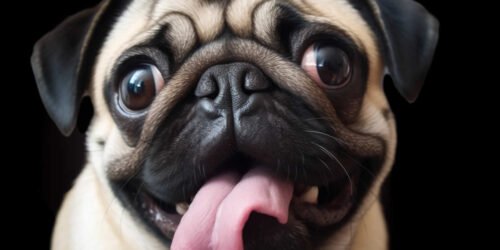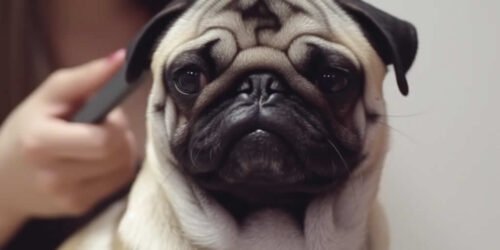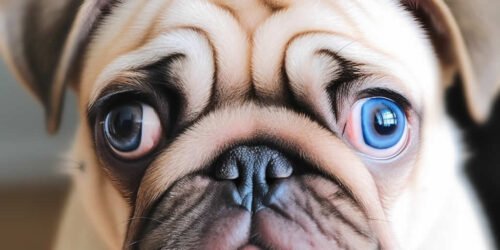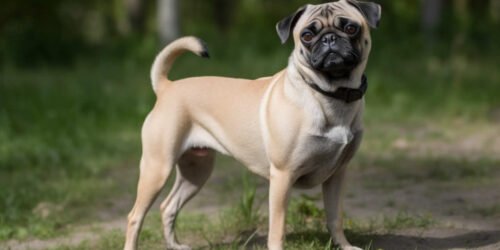Do Pugs Drool?
Introduction
Ever wondered why your cute pug seems to drool more than other dog breeds? It’s an intriguing fact that pugs have a higher tendency to slobber, largely due to their unique facial structure.
In this helpful guide, we’ll unpack the reasons behind why pugs drool and provide practical solutions on how you can manage it effectively. Ready for some slobbery truths?
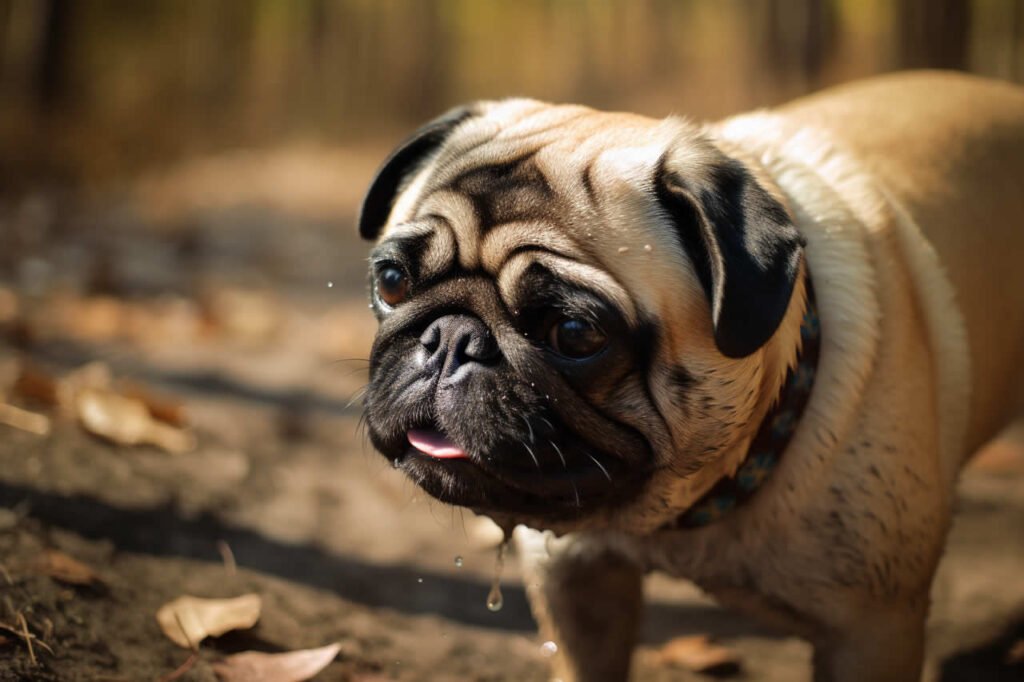
Table of Contents
- Introduction
- Understanding Pug Drooling
- Potential Causes of Excessive Drooling in Pugs
- How to Manage and Care for a Drooling Pug
- Conclusion
Understanding Pug Drooling
Pugs, like many other dog breeds, drool naturally, but excessive drooling can be a cause for concern.
Normal drooling in dogs, including Pugs
Just like any other dog, a Pug may drool occasionally. Drooling is a normal occurrence in many breeds and it typically happens when they’re salivating over food or after drinking plenty of water.
If your Pug is excited or nervous, you might also notice a bit more saliva than usual around its mouth which is perfectly healthy behaviour too. However, what’s important to understand here is that while moderate drooling isn’t cause for alarm, excessive drooling could be indicative of underlying health issues.
So, while you should get used to seeing some amount of slobber from your future pet Pug, always keep an eye out for anything unusual.
Causes of excessive drooling in Pugs
Pugs, like all dogs, may drool occasionally. However, excessive salivation could indicate underlying health issues that need addressing. Some of the common reasons your pug might be drooling excessively include dental problems; these can range from tartar buildup and gum disease to tooth decay or mouth injuries.
Respiratory problems due to their flat faces can also lead to increased salivation. Another factor could be overhydration; your pug might simply be drinking more water than necessary and this results in extra saliva production.
Lastly, heat and stress are known triggers for excessive drooling among pugs – it’s their way of cooling off or reacting to stressful situations they find themselves in.
Potential Causes of Excessive Drooling in Pugs
Excessive drooling in pugs can be caused by various factors, such as dental issues, overhydration, playing with water excessively, respiratory problems, and heat or stress.
Dental issues
Pugs can be prone to dental issues that may result in excessive drooling. These adorable pets often have crowded teeth due to their small mouths, making it easy for food particles to get lodged and plaque to build up.
This can lead to gum disease or Periodontitis – a painful condition causing increased salivation as one symptom. Pugs are also susceptible to tooth loss, another factor triggering saliva overflow.
Regular brushing of your Pug’s teeth is crucial in preventing these dental problems from developing into serious health concerns. Always consult with a vet if you notice changes in your dog’s drooling patterns, as this could point towards underlying dental issues.
Overhydration
Overhydration can be another potential cause of excessive drooling in Pugs. Pugs have a tendency to drink more water than necessary, especially if it is readily available to them. This can lead to overhydration, which in turn can cause increased salivation and drooling.
It’s important for pet owners to monitor their Pug’s water intake and ensure they are not consuming excessive amounts. Providing fresh water at regular intervals throughout the day, rather than leaving a constant supply, can help prevent overhydration and minimise drooling episodes.
Playing with water
Pugs are known to be playful and mischievous, and their love for water is no exception. Many pugs enjoy splashing around in puddles or playing with water toys, which can lead to increased drooling.
When pugs get excited during water playtime, their salivary glands kick into overdrive, resulting in more drool than usual. This is completely normal behaviour for most pugs and shouldn’t be a cause for concern.
However, if you notice excessive drooling even when your pug isn’t playing with water, it may be worth consulting with a veterinarian to rule out any underlying health issues. So don’t be surprised if your playful little pug leaves behind a few wet spots after some fun water antics!
Respiratory problems
Respiratory problems can also contribute to excessive drooling in Pugs. Due to their short snouts and flat faces, Pugs are more prone to respiratory issues such as brachycephalic airway syndrome.
This condition can cause difficulty in breathing, which can lead to panting and drooling. Additionally, if a Pug has allergies or is exposed to irritants like smoke or dust, it may also result in respiratory distress and increased drooling.
It’s important to be aware of these potential problems when considering a Pug as a pet and take the necessary steps to keep them comfortable and healthy. Regular check-ups with a veterinarian can help identify any underlying respiratory issues early on and ensure your precious Pug gets the care they need.
Heat and stress
Excessive heat and stress can also contribute to a pug’s drooling tendencies. Pugs have a shortened muzzle, which makes it more difficult for them to regulate their body temperature efficiently.
This means they are more prone to overheating and excessive drooling when exposed to hot weather or stressful situations. It is crucial to keep your pug cool and comfortable, especially during the summer months, by providing plenty of shade and fresh water.
Additionally, be mindful of any stressful environments or activities that may cause your pug to become anxious or nervous as this can also lead to increased drooling. Regular breaks in a calm environment can help minimise their stress levels and reduce excessive drooling episodes.
How to Manage and Care for a Drooling Pug
To manage and care for a drooling Pug, make sure to give them regular dental care, monitor their water intake, keep them cool and comfortable, and consult with a veterinarian if needed.
Regular dental care
Proper dental care is essential for maintaining your pug’s overall health and preventing excessive drooling. Here are some important tips to keep in mind:
- Brush their teeth regularly: Use a soft-bristled toothbrush and dog-friendly toothpaste to brush your pug’s teeth at least 2-3 times a week. This helps remove plaque and tartar buildup, which can contribute to dental issues and excessive drooling.
- Provide dental chews and toys: Chewing on appropriate dental chews or toys can help reduce plaque build-up and keep your pug’s teeth clean. Look for products specifically designed to promote oral health.
- Watch their diet: Feeding your pug a balanced diet that promotes good oral health is crucial. Opt for high-quality dog food that contains ingredients beneficial for dental hygiene, such as crunchy kibbles or special dental formulas.
- Regular veterinary check-ups: Schedule regular visits with your veterinarian to monitor your pug’s oral health. They can perform professional cleanings if necessary and provide guidance on maintaining good dental hygiene.
- Be aware of signs of dental problems: Keep an eye out for signs of dental issues, such as bad breath, swollen gums, difficulty chewing, or changes in appetite. If you notice any of these symptoms, consult with your vet immediately.
Monitoring water intake
It is essential to keep an eye on your pug’s water intake to ensure their overall health and well-being. Here are some tips for monitoring their water intake:
- Provide fresh water: Always make sure your pug has access to clean, fresh water throughout the day. Change the water regularly to keep it free from contaminants.
- Control portion sizes: Pugs have a tendency to overeat and overdrink, leading to potential health issues such as obesity or excessive drooling. Measure out the appropriate amount of water for your pug based on their age, size, and activity level.
- Establish a schedule: Set specific times for offering water to your pug, such as after meals or during playtime. This helps regulate their drinking habits and prevents excessive consumption.
- Observe behaviour: Pay attention to how much your pug drinks at each sitting. If they consistently finish their entire bowl quickly or seem constantly thirsty, it may be a sign of underlying health problems that require veterinary attention.
- Limit exposure to excessive heat: Pugs are prone to overheating due to their short snouts and compact bodies. Avoid leaving them outside in hot weather for extended periods and provide plenty of shade and cool areas indoors. This will help prevent excessive panting and drooling caused by dehydration.
Keeping Pugs cool and comfortable
Pugs are adorable and lovable pets, but they can be prone to drooling. To keep your pug cool and comfortable, here are some important tips:
- Provide a cool living environment: Pugs are sensitive to heat, so ensure that their living space is well-ventilated and kept at a comfortable temperature.
- Use air conditioning or fans: During hot weather, it is essential to keep your pug’s environment cool. Use air conditioning or fans to maintain a comfortable temperature indoors.
- Avoid hot surfaces: Pugs have delicate paw pads that can easily burn on hot surfaces like pavement or sand. Walk them on grass or use protective booties to prevent their paws from getting injured.
- Provide plenty of fresh water: Always make sure your pug has access to clean and fresh water throughout the day. This helps them stay hydrated, especially during warmer months when they may need extra water.
- Consider cooling mats or beds: Cooling mats or beds can provide relief for your pug by lowering their body temperature when lying down. These products are designed to dissipate heat and keep your pup cool and comfortable.
- Limit exercise in hot weather: Pugs can overheat quickly due to their short noses and compromised breathing ability. Avoid strenuous activities during the hottest parts of the day and opt for walks during cooler mornings or evenings instead.
- Avoid leaving them in hot cars: It’s crucial never to leave your pug unattended in a parked car, even for a few minutes. Cars heat up rapidly, and it can be life-threatening for your pet.
- Offer shade outdoors: If your pug spends time outdoors, ensure there is ample shade available where they can relax comfortably without being exposed to direct sunlight.
- Use dog-friendly sunscreen: Pugs have thin fur, making them prone to sunburns on areas with less hair coverage like their nose and ears. Consult with your veterinarian about using a dog-friendly sunscreen to protect their sensitive skin.
- Watch for signs of overheating: Be vigilant for signs of heatstroke in your pug, such as excessive panting, drooling, weakness, or collapse. If you suspect overheating, seek immediate veterinary attention.
Consultation with a veterinarian
If you’re considering getting a pug as a pet, it’s essential to consult with a veterinarian who has experience with this breed. A vet can provide valuable insights and guidance on various aspects of caring for your pug, including managing their drooling tendencies.
They will be able to assess the specific drooling patterns in your pug and rule out any underlying health issues that could be causing excessive drooling. Additionally, a veterinarian can recommend preventive measures and suggest suitable dental care routines to keep your pug’s mouth healthy.
By seeking professional advice from a vet, you’ll ensure that you are equipped with the knowledge necessary to provide the best care for your furry friend.
Conclusion
In conclusion, yes, pugs do drool. While it is normal for dogs to drool to some extent, pugs are known to be a bit more on the slobbery side. However, excessive drooling in pugs could be a sign of dental issues, overhydration or even respiratory problems.
It’s important for pug owners to keep an eye on their pet’s drooling and seek veterinary care if needed. Remember, a little bit of slobber can’t dampen the love and joy these adorable wrinkly-faced pups bring into our lives!

